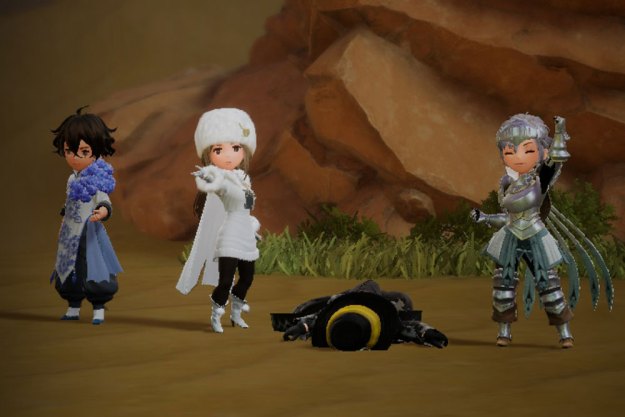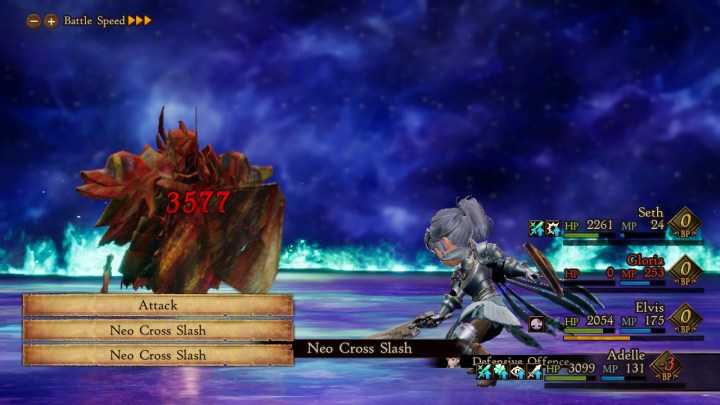
“The Brave and Default system strikes a near-perfect balance between two rival battle mechanics that have struggled to co-exist over the decades, but that's about the extent of this game's individuality.”
- Strategic Brave/Default system
- Useful jobs
- Bosses are hard but fair
- Enjoyable voice acting
- Reused music
- Boring visuals
- Bland gameplay loop
Bravely Default was born to hark back to the JRPGs of yore. The genre made it big with globe-trotting adventures where slow and steady turn-based battles gave us ample time to think through each battle decision. Then came the Active Time Battle system, which speeds up the slog of traditional turn-based combat. The newer system seems better-suited to our need of twice-a-minute news feed refreshes and hot-take tweets.
While Bravely Default 2 sounds like the perfect answer to those wanting a traditional take with a hint of something new, the new RPG embraces the past without stopping to understand why the systems it attempts to emulate fell out of fashion in the first place.
A strained start
Like its predecessor, Bravely Default 2 offers a unique spin on combat on top of a generic RPG story. As soon as the game begins, our seafaring hero is marooned on a beach after being saved by a talking crystal as he unconsciously floats through the ocean. At that moment, we’re only an amnesia cliché away from a hat trick right out of the gate.
It’s just a shame that after a couple of hours, you’ve seen close to everything it will ever offer.
It’s not that there’s anything inherently bad about a story involving elementally attuned chunks of geological matter. I absolutely adored Final Fantasy III. But it’s an RPG standby that’s been done to death — a boilerplate chronicle that makes it hard to shake the idea that Bravely Default 2 takes the idea of RPG nostalgia a little too far.

What I can give Bravely Default 2 early credit for is just how quickly it gets going. Rather than sit through what can feel like a good hour of chitchat and tutorials, players get their first permanent party members almost as soon as they wash up ashore, with a fourth and final teammate arriving just down the road. With the delightfully Scottish Elvis, his hired hand Adelle, and the unashamedly British Gloria at your side, you’re on your way to meet the game’s wide-ranging international cast of characters. The foundations are laid fast –it’s just a shame that after a couple of hours, you’ve seen close to everything it will ever offer.
Once the lengthy prologue chapter ends, players have mostly seen it all. They’ll have dealt with a crisis in the chapter’s chosen city, wandered aimlessly through countless corridors in a couple of themed dungeons, fought a powerful boss or two, and made their way to a wholly new geographical location with a crystal in hand and a rumor of the next one’s location. And that’s exactly what they’ll do again and again. In at least 30 hours with the game, players see virtually nothing new beyond that opening chapter. They just repeat the same journey disguised as a new outing until the credits eventually roll.
Same systems, same headaches
Where Bravely Default 2 does manage to iterate on its inspirations is the job system — a feature of Final Fantasy III that’s served as a basis for any JRPG ever since. “Asterisks” robbed from bosses throughout the story unlock equippable classes like Thief, Red Mage, Bard, and Berserker — all of which come with unique spells, abilities, passive skills, and special attacks to spice up your strategy.

Once players get into the habit of using the namesake Brave and Default systems, which allow characters to bank turns instead of attacking to string them together later on, combat becomes relatively straightforward. But it’s the returning, refined job system that successfully stands to support future battle strategies.
Characters can only use spells from the two jobs they have equipped at the time but, once unlocked, passive skills from any job can be mixed and matched whenever. Even if players aren’t planning to weave a new job into their team, there’s reason to theorycraft how its passive abilities can augment your current setup. Each one caps out at level 12, so treading down the path of experimentation doesn’t take long either.
It’s the returning, refined job system that successfully stands to support future battle strategies.
There’s little inherently new about the obtainable roles compared to similar games, but having each party member specialize in any two at a time opens the doors to some wonderful customization options — like a White Mage dabbling in Bard buffs or a Monk taking cues from the Berserker role to hit even harder. It becomes a key aspect in tackling some trickier bosses. Grinding levels to brute force through these brick walls can work, but the right strategy is always hidden in plain sight for freethinkers to find.
The right idea, the wrong execution
If anything, it’s intriguing to see the need for the Bravely Default series to exist in the first place. It doesn’t offer much that can’t be had elsewhere. My personal favorite JRPG, Lost Odyssey — which just so happens to be the birth child of Final Fantasy creator Hironobu Sakaguchi — came from a similar need to satisfy those looking for a nostalgic, yet modern take on the genre. Unsurprisingly, it hit a snag among critics for embracing the traditional systems that some consider laborious and old-fashioned: Long, chatty cutscenes, turn-based battles with a minor tweak, and random encounters that padded out the whole journey.

It’s easy to see why the latter went away over the years. The game becomes a slog when players find themselves in their fourth virtually identical dungeon as it forks into five different paths, each one full of lengthy, unavoidable battles. The battles aren’t fully random, but even adopting the modern approach of enemies appearing on the overworld map fails in this instance.
The game becomes a slog when players find themselves in their fourth virtually identical dungeon.
When traveling to and from dungeons and cities, the small but wide world poses no real threat. But get into a dungeon and its long, thin corridors lack the space needed to avoid most fights if players just want to explore or reach the exit fast and get on with the game. It’s a jarring contrast that’s likely to frustrate both RPG purists and those who are hoping for a more modern experience.
Our take
The reason to question Bravely Default 2‘s existence boils down to its inability to think for itself. The Brave and Default combat system strikes a near-perfect balance between two rival battle mechanics that have struggled to coexist over the decades, but that’s about the extent of the game’s individuality.
Beyond that, it features a comically overused premise, music that’s simply remixed to suit your current locale, countless dungeons that offer no new experiences and only serve to pad the game’s supposed worth, and an overall gameplay loop that’s worn out before the end of the first chapter. Besides looking a bit nicer on newer hardware, the reason for this sequel’s existence isn’t clear.
Is there a better alternative out there?
World of Final Fantasy and Lost Sphear both spring to mind as JRPGs that manage to strike a delicate balance between old and new values in gaming. This game exists to pander to those nostalgic for the JRPGs of the past, but it doesn’t offer much that those games hadn’t already.
How long will it last?
Over 60 hours, which is too long, quite frankly. Unlike some shorter RPGs, this one spins the most basic of storylines and stretches it far beyond its breaking point.
Should you buy it
No, though it might be a suitable entry point for young players who want an introduction to the genre. If you’ve already been around the block though, there are far better options out there.
Editors' Recommendations
- Octopath Traveler 2 brings another retro-style RPG to Switch in February
- Bravely Default 2: Every job in the game and how to unlock them




